Method and kits for multiplex hybridization assays
a hybridization and kit technology, applied in the field of methods and kits for multiplex hybridizationbased assays, can solve the problems of affecting detection, difficult to determine whether a lack of signal in a readout is present, and the difficulty of such determinations is exacerbated
- Summary
- Abstract
- Description
- Claims
- Application Information
AI Technical Summary
Benefits of technology
Problems solved by technology
Method used
Image
Examples
example
Genotyping Genetic Polymorphisms in Drug Metabolic Enzyme and Transporter Genes Using Circularizable Probes
[0066] In this example, nucleic acid standards and molecular inversion probes (having target-specific regions of length in the range of 36 to 64 nucleotides) are prepared for 177 loci of genes in the set listed in Table I. Of these loci, interfering polymorphic loci are listed in Table II. Molecular inversion probes are designed as described in U.S. Pat. No. 6,858,412 and Hardenbol et al, Nature Biotechnology, 21: 673-678 (2003), which are incorporated herein by reference. Labeled oligonucleotide tags generated from the assay are hybridized to a GeneChip™ array of tag complements are analyzed on a GeneChip™ Scanner 3000 (Affymetrix, Santa Clara, Calif.) using the manufacturer's recommended protocols. The protocol of the above references is generally followed, subject to the following modifications, described in the MegAllele™ Genotyping System User Manual, available from the m...
PUM
| Property | Measurement | Unit |
|---|---|---|
| Tm | aaaaa | aaaaa |
| temperatures | aaaaa | aaaaa |
| temperatures | aaaaa | aaaaa |
Abstract
Description
Claims
Application Information
 Login to View More
Login to View More - R&D
- Intellectual Property
- Life Sciences
- Materials
- Tech Scout
- Unparalleled Data Quality
- Higher Quality Content
- 60% Fewer Hallucinations
Browse by: Latest US Patents, China's latest patents, Technical Efficacy Thesaurus, Application Domain, Technology Topic, Popular Technical Reports.
© 2025 PatSnap. All rights reserved.Legal|Privacy policy|Modern Slavery Act Transparency Statement|Sitemap|About US| Contact US: help@patsnap.com



